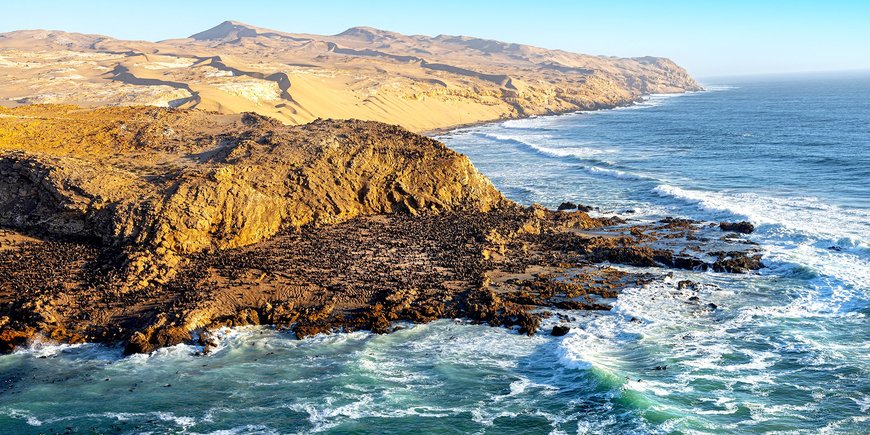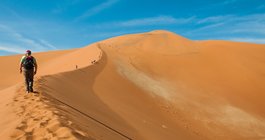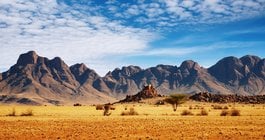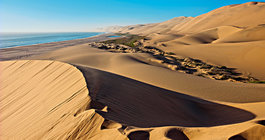Offer advantages
- unconventional trail
- face-to-face encounters with local tribes
- landscape diversity: from the magnificent Sossusvlei dunes to the Skeleton Coast
- wild animals in their natural habitat
Różne oblicza Namibii Code: WDHNOL1
Różne oblicza Namibii
Code: WDHNOL1
Departure to Namibia.
2nd DAY OF WINDHUK.
Arrival in Namibia. Completion of visa formalities at the airport. Acquaintance with the leader of the expedition. Currency exchange, purchase of a SIM card for those willing (out of range possible in many places). Transfer to the capital of Namibia - WINDHUK. Lunch and hotel accommodation. In the afternoon, explore the capital from the perspective of a citizen, covering both rich and less affluent neighborhoods. Dinner and overnight at the hotel. Length of the route: approx. 45 km.
3. DAY. FLAT WATERBERG
Breakfast, check-out and drive to the area of WATERBERG FLAT. On the way, visit a Herero village near Okakarara. The Herero is a nation of deeply entrenched pride, living mostly from agriculture. His prosperity is often expressed in the number of cows he owns, which is also evident in the traditional dress of women. The headdress is shaped like a cow's horn and the rest of the attire is a Victorian gown which is shaped to resemble a cow's torso. A visit to the village is unplanned - we are looking at the real life of the inhabitants. Lunch. Then, climb (approx. 400 m) above the plains of the plateau, from which there is a beautiful landscape. The area of the plateau, which rises to a height of approx. 1878 m above sea level. roamed by dinosaurs that left their traces approx. 200 million years ago! Waterberg is also a place of historical importance. It was here that the last battle of the Herero uprising against Germany in 1904-1908 took place. In the evening, dinner by the fire and overnight in tents at the campsite. Length of the route: approx. 320 km.
4. DAY. OTJIWARONGO - TSINSABIS
Breakfast at the campsite. Transfer to the crocodile farm in OTJIWARONGO and to the Cheetah Conservation Fund. In addition to a close meeting with cheetahs, you will be able to learn about the program of protection of the world's fastest mammals in danger of extinction. Access to the site of the later campsite near TSINSABIS. It is a place run by the San community and their culture will be the theme of this evening and the next morning. The San, called "Bushmen" by European settlers, have lived in southern Africa for over 30,000 years. They lead a nomadic lifestyle. They can be found in Botswana, Namibia and South Africa. The evidence of this are the numerous drawings on the rocks in these countries. Lunch. during the day, depending on the pace of the program implementation - outdoors in the form of a picnic Evening dinner by the fire and overnight in tents Length of the route: approx. 330 km.
5. DAY. ETOSHA NATIONAL PARK
Breakfast and check out. Safari in the ETOSHA NATIONAL PARK to search for animals. Etosha is home to 114 species of mammals, 340 species of birds, 110 species of reptiles, 14 species of amphibians and, surprisingly, one species of fish. The area of the park is approx. 22 thousand square meters. km², which is approximately the area of the Zachodniopomorskie voivodship. The heart of Etosha is the trough - a dry reservoir that was once filled with the water of the Kunene River, the bottom of which is most often made of dried salt and clay. Only with very heavy rainfall, the eastern part of the basin fills up with water. Lunch - depending on how the day will be in the form of a picnic or at the campsite. Transfer to the camping, dinner and overnight in tents. Length of the route: approx. 220 km.
DAY 6. ETOSHA NATIONAL PARK
After breakfast, check out and go on safari. Travel between waterholes in search of animals. Lunch break at one of the Etosha resorts. Transfer to the campsite, accommodation, dinner and overnight in tents. Length of the route: approx. 80 km.
7th DAY. ONAANDA (OWAMBOLAND)
Breakfast and departure from the campsite. Crossing the veterinary fence, the so-called The "red line" which is a symbol of the apartheid division of the country. Transfer to the most populous zone of Namibia - the land of Owamboland, the name of which is a relic of the apartheid times. As you drive through this region, you can see its unique character - architectural chaos. Lunch in one of the shabeens (local bars that, apart from the color, have perhaps the most original names in the world), and the opportunity to try the local specialty, Shifima (a traditional Namibian porridge-like dish). Accommodation at a campsite near ONAANDA, dinner and overnight in a tent. Length of the route: approx. 220 km.
8th DAY. OPUWO (KAOKOLAND)
Breakfast at the camp, transfer to another region of Namibia, whose unofficial name Kaokoland, in common use, is a legacy of the times of racial segregation when modern Namibia was known as Southwest Africa and was occupied by South Africa. Visit to Himba village. The Himba, descendants of the Herero group, are a nomadic pastoral tribe inhabiting the area of Kaokoland, living for centuries according to their traditions. Himba women are known for their unique beauty, which is emphasized by characteristic hairstyles and jewelry. The male outfit is made of short goatskin skirts. Their body care is based on rubbing red ocher and animal fat. These treatments protect against the scorching sun and insects. Lunch outdoors. Accommodation, dinner and overnight at the lodge in OPUWO. Length of the route: approx. 220 km.
9. DAY. POOR
Breakfast and check out. The second day of the stay was planned in the capital of the region: OPUWO, which to this day remains one of the least populated corners of the world - there is only one street in the town. The harsh and sunburnt landscape from the noon hours turns into a landscape of pastel shadows in the evening and morning hours. Lunch during the day. Return to your accommodation and dinner at the lodge.
10. DAY. TWYFELFONTEIN (DAMARALAND)
Breakfast, check-out and departure. On this day, the ride is mainly over gravel roads. Drive among the villages of the Herero and Damara people, if the opportunity arises, the opportunity to taste fresh bread or donuts made by local women who sell their wares along the way. Lunch during the day in the Ongongo area. Possible visit to the local school. The day will end with a drive through Game Reserve Palmwag. If you are lucky, you will be able to see the "desert four" in the reserve, i.e. the elephant, lion, giraffe and rhino. Setting up the camp in the vicinity of TWYFELFONTEIN, dinner and overnight in tents. Length of the route: approx. 350 km.
11. DAY. SPITZKOPPE
Breakfast and departure from the camp. A visit to the Damara open-air museum - Damara Living Museum - another ethnic group living in Namibia, which is a real enigma for anthropologists. In addition to the San, Damara is believed to be one of the oldest ethnic groups in Namibia today. Their traditions and customs are a mixture of archaic hunter-gatherer and shepherd culture. Their origin remains unclear. Onward transfer and search for desert elephants on the Aba Huab River. During the day stop for lunch in Uis, in the evening drive to the area of SPITZKOPPE. Dinner in the camp, overnight in tents overlooking the mountain. Length of the route: approx. 235 km.
12. DAY. CAPE CROSS - SWAKOPMUND
Breakfast overlooking the sunrise over Mount Spitzkoppe. This mountain, called the Matterhorn of Africa, resembles the most beautiful peak of the Alps. It rises to a height of about 1,800 m above sea level. Eviction from the camp. Drive towards the coast. You can experience climate change on this day - it will get a lot colder. The first European to land in this part of the world was the Portuguese explorer Diego Cao (in 1486), who erected a stone cross on the CAPE CROSS in honor of the Portuguese King John II (now you can see a replica of the original). A visit to the largest colony of dwarf cats, for which this place is also known. Drive along the coast to SWAKOPMUND, lunch during the day, hotel accommodation. Overnight. Length of the route: approx. 300 km.
DAY 13. SWAKOPMUND
Breakfast. Visiting SWAKOPMUND. This port town is a well-preserved example of German colonial architecture. Walk around the city and free time. Optional (extra charge on site): desert quad bike ride, boat trip in search of pelicans and dolphins or an expedition to Sandwich Harbor. Return to the hotel. Overnight.
14. DAY. SESRIEM
Breakfast, check out and drive towards the Namib Desert to SESRIEM. This desert landscape will accompany you until the end of the trip. The goal of this day is to get to the famous Sossusvlei and Dead Vlei. The sand dunes are considered to be one of the largest in the world, up to 300 m high. The original red color of the sand and its unusual location make it one of the most photogenic places on Earth. Another spectacular place is Dead Vlei, also known as the "dead valley". It is characterized by the dried up stumps of acacia trees and dry and cracked ground that contrasts with the red dunes, creating an unusual landscape. Lunch. Transfer to the campsite. Dinner and overnight in tents. Overnight. planned in the park in order to be able to see the sunset over the dunes Length of the route: approx. 350 km.
15. DAY. NAMIB-SCIENCE NATIONAL PARK
Breakfast and departure from the campsite. Drive through the NAMIB-SCIENCE NATIONAL PARK, which is the fourth largest protected area in the world. The park covers most of the Namib Desert and the Naukluft Mountains. Rare species of animals occur here, i.e. Mountain zebra, desert giraffe, oryx antelope and springbok. Lunch during the day. Check-in and farewell dinner at the lodge. Overnight. Length of the route: approx. 150 km.
DAY 16. WINDHUK
Breakfast, check out. Transfer to the airport in WINDHUK. Departure to Poland. Length of the route: approx. 370 km.
17. DAY.
Arrival to Poland.
14 nights: 6 nights in hotels *** / lodges; 2-person rooms with bathrooms (Windhoek, Opuwo, Swakopmund) • 8 nights in tents at campsites with basic sanitary facilities • meals according to the program: 14 breakfasts, 13 lunches, 12 dinners • care of the Polish-speaking leader from the airport in Windhoek to transfer to the airport in Windhoek • entry tickets to national parks according to the program • transfers by 4x4 cars • KL and NW insurance
Namibia
Namibia to miejsce gdzie nie dotarła jeszcze masowa turystyka i gdzie przetrwały plemiona o fascynujących zwyczajach: Himba, Herero i Buszmeni. Bogaty świat fauny w Parku Narodowym Etosha, najstarsza pustynia świata – Namib, fantastyczne pomarańczowe wydmy i kolorowe miasteczka pozostałe po kolonizatorach to skarby czekające na odkrycie.
Windhoek • Waterberg Plateau • Otjiwarongo • Tsinsabis • Etosha National Park • Onaanda (Owamboland) • Opuwo (Kaokoland) • Twyfelfontein (Damaraland) • Spitzkoppe • Cape Cross • Swakopmund • Sesriem • Namib-Naukluft National Park • Windhoek
This is a 4x4 car trip through well-known places and those off the beaten track. Explore the oldest desert in the world - the Namib. Drive along the sinister and inhospitable Skeleton Coast, see the colony of cats at Cape Cross. Travel back in time and stroll through the colonial patch of Germany at Swakopmund. Spend the night in Spitzkoppe overlooking the Milky Way and the Southern Cross. Look for desert elephants in the Aba Huab River. Visit the local villages of Damara and Himba. Meet the communities - Herera, Sam, Owambo. Drive along the Kunene River on a road that has little left in Africa. Enter the animal kingdom of Etosha National Park. Cut yourself off from civilization and "feel" Africa for a while. During the several stages of the journey, our goal is to reach hidden corners where patience becomes the most valuable companion of any traveler! Remember - time flows differently in Africa, and this is a real expedition, focused on getting to know the culture of Namibia.
1. DAY. Departure to Namibia.
2nd DAY OF WINDHUK. Arrival in Namibia. Completion of visa formalities at the airport. Acquaintance with the leader of the expedition. Currency exchange, purchase of a SIM card for those willing (out of range possible in many places). Transfer to the capital of Namibia - WINDHUK. Lunch and hotel accommodation. In the afternoon, explore the capital from the perspective of a citizen, covering both rich and less affluent neighborhoods. Dinner and overnight at the hotel. Length of the route: approx. 45 km.
3. DAY. FLAT WATERBERG Breakfast, check-out and drive to the area of WATERBERG FLAT. On the way, visit a Herero village near Okakarara. The Herero is a nation of deeply entrenched pride, living mostly from agriculture. His prosperity is often expressed in the number of cows he owns, which is also evident in the traditional dress of women. The headdress is shaped like a cow's horn and the rest of the attire is a Victorian gown which is shaped to resemble a cow's torso. A visit to the village is unplanned - we are looking at the real life of the inhabitants. Lunch. Then, climb (approx. 400 m) above the plains of the plateau, from which there is a beautiful landscape. The area of the plateau, which rises to a height of approx. 1878 m above sea level. roamed by dinosaurs that left their traces approx. 200 million years ago! Waterberg is also a place of historical importance. It was here that the last battle of the Herero uprising against Germany in 1904-1908 took place. In the evening, dinner by the fire and overnight in tents at the campsite. Length of the route: approx. 320 km.
4. DAY. OTJIWARONGO - TSINSABIS Breakfast at the campsite. Transfer to the crocodile farm in OTJIWARONGO and to the Cheetah Conservation Fund. In addition to a close meeting with cheetahs, you will be able to learn about the program of protection of the world's fastest mammals in danger of extinction. Access to the site of the later campsite near TSINSABIS. It is a place run by the San community and their culture will be the theme of this evening and the next morning. The San, called "Bushmen" by European settlers, have lived in southern Africa for over 30,000 years. They lead a nomadic lifestyle. They can be found in Botswana, Namibia and South Africa. The evidence of this are the numerous drawings on the rocks in these countries. Lunch. during the day, depending on the pace of the program implementation - outdoors in the form of a picnic Evening dinner by the fire and overnight in tents Length of the route: approx. 330 km.
5. DAY. ETOSHA NATIONAL PARK Breakfast and check out. Safari in the ETOSHA NATIONAL PARK to search for animals. Etosha is home to 114 species of mammals, 340 species of birds, 110 species of reptiles, 14 species of amphibians and, surprisingly, one species of fish. The area of the park is approx. 22 thousand square meters. km², which is approximately the area of the Zachodniopomorskie voivodship. The heart of Etosha is the trough - a dry reservoir that was once filled with the water of the Kunene River, the bottom of which is most often made of dried salt and clay. Only with very heavy rainfall, the eastern part of the basin fills up with water. Lunch - depending on how the day will be in the form of a picnic or at the campsite. Transfer to the camping, dinner and overnight in tents. Length of the route: approx. 220 km.
DAY 6. ETOSHA NATIONAL PARK After breakfast, check out and go on safari. Travel between waterholes in search of animals. Lunch break at one of the Etosha resorts. Transfer to the campsite, accommodation, dinner and overnight in tents. Length of the route: approx. 80 km.
7th DAY. ONAANDA (OWAMBOLAND) Breakfast and departure from the campsite. Crossing the veterinary fence, the so-called The "red line" which is a symbol of the apartheid division of the country. Transfer to the most populous zone of Namibia - the land of Owamboland, the name of which is a relic of the apartheid times. As you drive through this region, you can see its unique character - architectural chaos. Lunch in one of the shabeens (local bars that, apart from the color, have perhaps the most original names in the world), and the opportunity to try the local specialty, Shifima (a traditional Namibian porridge-like dish). Accommodation at a campsite near ONAANDA, dinner and overnight in a tent. Length of the route: approx. 220 km.
8th DAY. OPUWO (KAOKOLAND) Breakfast at the camp, transfer to another region of Namibia, whose unofficial name Kaokoland, in common use, is a legacy of the times of racial segregation when modern Namibia was known as Southwest Africa and was occupied by South Africa. Visit to Himba village. The Himba, descendants of the Herero group, are a nomadic pastoral tribe inhabiting the area of Kaokoland, living for centuries according to their traditions. Himba women are known for their unique beauty, which is emphasized by characteristic hairstyles and jewelry. The male outfit is made of short goatskin skirts. Their body care is based on rubbing red ocher and animal fat. These treatments protect against the scorching sun and insects. Lunch outdoors. Accommodation, dinner and overnight at the lodge in OPUWO. Length of the route: approx. 220 km.
9. DAY. POOR Breakfast and check out. The second day of the stay was planned in the capital of the region: OPUWO, which to this day remains one of the least populated corners of the world - there is only one street in the town. The harsh and sunburnt landscape from the noon hours turns into a landscape of pastel shadows in the evening and morning hours. Lunch during the day. Return to your accommodation and dinner at the lodge.
10. DAY. TWYFELFONTEIN (DAMARALAND) Breakfast, check-out and departure. On this day, the ride is mainly over gravel roads. Drive among the villages of the Herero and Damara people, if the opportunity arises, the opportunity to taste fresh bread or donuts made by local women who sell their wares along the way. Lunch during the day in the Ongongo area. Possible visit to the local school. The day will end with a drive through Game Reserve Palmwag. If you are lucky, you will be able to see the "desert four" in the reserve, i.e. the elephant, lion, giraffe and rhino. Setting up the camp in the vicinity of TWYFELFONTEIN, dinner and overnight in tents. Length of the route: approx. 350 km.
11. DAY. SPITZKOPPE Breakfast and departure from the camp. A visit to the Damara open-air museum - Damara Living Museum - another ethnic group living in Namibia, which is a real enigma for anthropologists. In addition to the San, Damara is believed to be one of the oldest ethnic groups in Namibia today. Their traditions and customs are a mixture of archaic hunter-gatherer and shepherd culture. Their origin remains unclear. Onward transfer and search for desert elephants on the Aba Huab River. During the day stop for lunch in Uis, in the evening drive to the area of SPITZKOPPE. Dinner in the camp, overnight in tents overlooking the mountain. Length of the route: approx. 235 km.
12. DAY. CAPE CROSS - SWAKOPMUND Breakfast overlooking the sunrise over Mount Spitzkoppe. This mountain, called the Matterhorn of Africa, resembles the most beautiful peak of the Alps. It rises to a height of about 1,800 m above sea level. Eviction from the camp. Drive towards the coast. You can experience climate change on this day - it will get a lot colder. The first European to land in this part of the world was the Portuguese explorer Diego Cao (in 1486), who erected a stone cross on the CAPE CROSS in honor of the Portuguese King John II (now you can see a replica of the original). A visit to the largest colony of dwarf cats, for which this place is also known. Drive along the coast to SWAKOPMUND, lunch during the day, hotel accommodation. Overnight. Length of the route: approx. 300 km.
DAY 13. SWAKOPMUND Breakfast. Visiting SWAKOPMUND. This port town is a well-preserved example of German colonial architecture. Walk around the city and free time. Optional (extra charge on site): desert quad bike ride, boat trip in search of pelicans and dolphins or an expedition to Sandwich Harbor. Return to the hotel. Overnight.
14. DAY. SESRIEM Breakfast, check out and drive towards the Namib Desert to SESRIEM. This desert landscape will accompany you until the end of the trip. The goal of this day is to get to the famous Sossusvlei and Dead Vlei. The sand dunes are considered to be one of the largest in the world, up to 300 m high. The original red color of the sand and its unusual location make it one of the most photogenic places on Earth. Another spectacular place is Dead Vlei, also known as the "dead valley". It is characterized by the dried up stumps of acacia trees and dry and cracked ground that contrasts with the red dunes, creating an unusual landscape. Lunch. Transfer to the campsite. Dinner and overnight in tents. Overnight. planned in the park in order to be able to see the sunset over the dunes Length of the route: approx. 350 km.
15. DAY. NAMIB-SCIENCE NATIONAL PARK Breakfast and departure from the campsite. Drive through the NAMIB-SCIENCE NATIONAL PARK, which is the fourth largest protected area in the world. The park covers most of the Namib Desert and the Naukluft Mountains. Rare species of animals occur here, i.e. Mountain zebra, desert giraffe, oryx antelope and springbok. Lunch during the day. Check-in and farewell dinner at the lodge. Overnight. Length of the route: approx. 150 km.
DAY 16. WINDHUK Breakfast, check out. Transfer to the airport in WINDHUK. Departure to Poland. Length of the route: approx. 370 km.
17. DAY. Arrival to Poland.
BENEFITS:14 nights: 6 nights in hotels *** / lodges; 2-person rooms with bathrooms (Windhoek, Opuwo, Swakopmund) • 8 nights in tents at campsites with basic sanitary facilities • meals according to the program: 14 breakfasts, 13 lunches, 12 dinners • care of the Polish-speaking leader from the airport in Windhoek to transfer to the airport in Windhoek • entry tickets to national parks according to the program • transfers by 4x4 cars • KL and NW insurance
NOTES:
Practical information
Offer details
Twój wybór wczasów
Namibia
Różne oblicza Namibii
- send an enquiry
- callcenter.tel_pl
- +48 77 4476707
- mon-fri: 8-17












